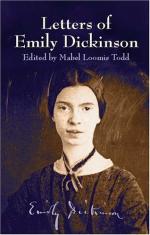|
This section contains 1,488 words (approx. 5 pages at 300 words per page) |

|
SOURCE: “Dickinson's ‘I heard a Fly buzz,’” in The Explicator, Vol. 43, No. 3, Spring, 1985, pp. 12-15.
In the following essay, Bachinger presents a reading of Dickinson's “I heard a Fly Buzz” as a response to John Donne's Sermon 78—in which she equates the fly with God.
“Why is that ‘Fly’ in the room? … And why, further, is death (the moment of death) personified as the ‘King,’ if that's what's being personified?” asks George Monteiro (The Explicator, 43[1], 44). Seeking a precedent for the conjunction of Fly and King, he notes that according to folklore, flies are permitted to dine at kings' tables because once, by mimicking nails at Christ's crucifixion, they spared him more. Consequently, Monteiro concludes, the conjunction of Fly and King was not Dickinson's invention, but “the grotesquerie of the conceptual meaning was undoubtedly the poet's” (45).
Monteiro is, I believe, on the right track in proposing a religious explication...
|
This section contains 1,488 words (approx. 5 pages at 300 words per page) |

|


